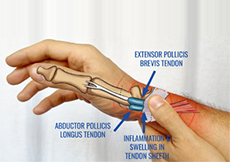De Quervain’s Tenosynovitis

What is de Quervain’s Tenosynovitis?
De Quervain’s Tenosynovitis refers to excessive inflammation in the lining of the tendons that pass through the wrist and into the thumb. Usually there is no damage to the tendon but there can be severe inflammation and pain in the sheath that surrounds it.
Why does de Quervain’s Tenosynovitis occur?
Some tendons have a lining (or sheath) that protect and lubricate the tendon as it slides back and forth with movement. Tenosynovitis occurs when that lining becomes inflamed. The lining of the tendons that pass over the wrist and into the thumb are particularly vulnerable to inflammation due to the anatomy of the wrist joint (a bit like a rope passing over a sharp rock). Repetitive wrist movement is the most common cause (caring for a baby that requiring constant lifting is one of the most common causes). Tenosynovitis can happen in anyone but is a little bit more common in people prone to inflammatory conditions.
What are the symptoms of de Quervain’s Tenosynovitis?
The most common feature is a sharp, localised and quite severe pain over the base of the thumb or side of the wrist whenever there is stretching or movement of the thumb tendons. There can also be swelling, pain with repetitive positions and sometimes pain that wakes you from your sleep.
How is de Quervain’s Tenosynovitis diagnosed?
De Quervain’s Tenosynovitis can be diagnosed by a careful examination by an experienced Sport and Exercise Physician without the need for any scans.
What is the treatment for de Quervain’s Tenosynovitis?
De Quervain’s Tenosynovitis is treated by resolving the inflammation in the tendon sheath. Depending on how severe it is, this can be quite difficult to settle down and usually a corticosteroid injection is required in combination with immobilisation in a customised brace. We usually manage this condition in a team approach with our hand therapy colleagues.
Is surgery required for de Quervain’s Tenosynofitis?
No. Surgery is only required if something unusual like a prominent bone spur was causing the tenosynovitis and needed to be removed.





















